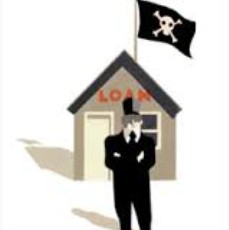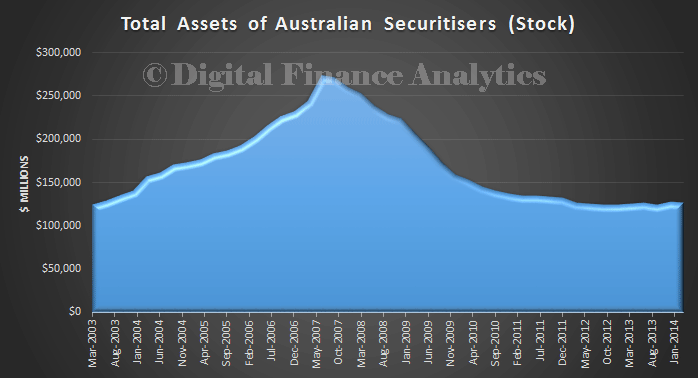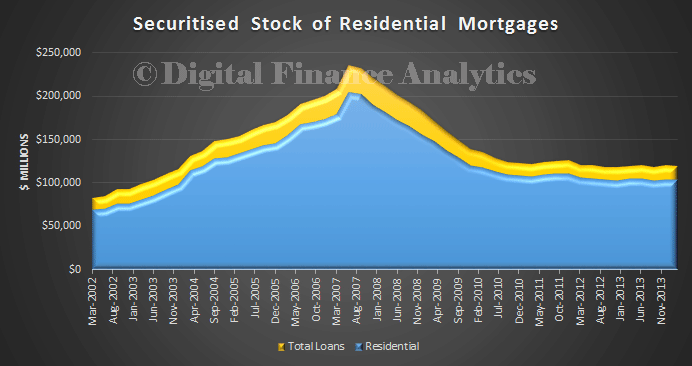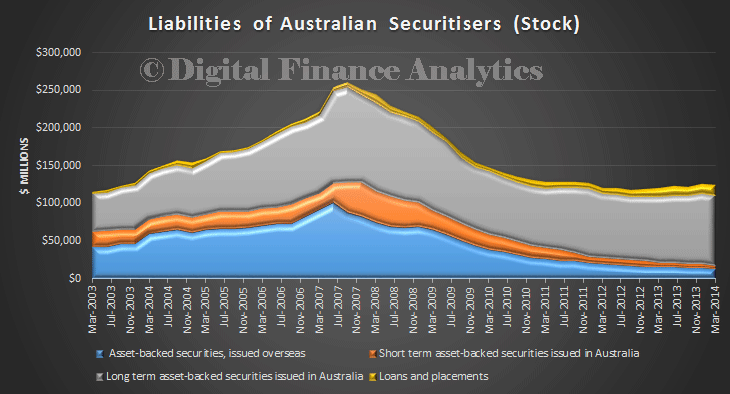
By Martin North, cross-posted from the Digital Finance Analytics Blog
The ABS just released their quarterly data on the assets and liabilities of Australian Securitisers. It included some revisions to earlier data, but the message is the same. Mortgages were down, assets were down, and liabilities were down. The proportion issued overseas also fell. Securitisation is not growing, despite some growth in loan volumes, though even this has stalled.
As at 31 March 2014, total assets of Australian securitisers were $127.5b, down $1.3b (1.0%) on 31 December 2013.

During the March quarter 2014, the fall in total assets was due to decreases in residential mortgage loans (down $0.7b, 0.7%), other loans (down $0.5b, 3.6%) and other assets (down $0.1b, 9.7%). Residential and non-residential mortgage assets, which accounted for 82.5% of total assets, were $105.2b as at 31 March 2014, a decrease of $0.8b (0.8%) during the quarter.
 As at 31 March 2014, total liabilities of Australian securitisers were $127.5b, down $1.3b (1.0%) on 31 December 2013. The fall in total liabilities was due to decreases in asset backed securities, issued overseas (down $1.2b, 8.7%), and short term asset-backed securities issued in Australia (down $0.5b, 10.0%). As at 31 March 2014, asset backed securities issued overseas as a proportion of total liabilities decreased to 10.0%, down 0.8 percentage points on the December quarter 2013 percentage of 10.8%. Asset backed securities issued domestically as a proportion of total liabilities increased to 77.5%, up 0.5% percentage points on the December quarter 2013 percentage of 77.0%.
As at 31 March 2014, total liabilities of Australian securitisers were $127.5b, down $1.3b (1.0%) on 31 December 2013. The fall in total liabilities was due to decreases in asset backed securities, issued overseas (down $1.2b, 8.7%), and short term asset-backed securities issued in Australia (down $0.5b, 10.0%). As at 31 March 2014, asset backed securities issued overseas as a proportion of total liabilities decreased to 10.0%, down 0.8 percentage points on the December quarter 2013 percentage of 10.8%. Asset backed securities issued domestically as a proportion of total liabilities increased to 77.5%, up 0.5% percentage points on the December quarter 2013 percentage of 77.0%.
 Most of the securities are being taken up by local investors, including super funds and the local banks. As a result, the mortgage-related risks are not being transferred offshore. As the local market consists a a small number of large players, many operating in the banking sector, across many business domains, these entities, which already directly leveraged into the property sector, will also have second order liabilities from purchasing securities portfolios. We wonder if the implied systemic risks are fully understood, especially as it is the long term securities which are being bought.
Most of the securities are being taken up by local investors, including super funds and the local banks. As a result, the mortgage-related risks are not being transferred offshore. As the local market consists a a small number of large players, many operating in the banking sector, across many business domains, these entities, which already directly leveraged into the property sector, will also have second order liabilities from purchasing securities portfolios. We wonder if the implied systemic risks are fully understood, especially as it is the long term securities which are being bought.

